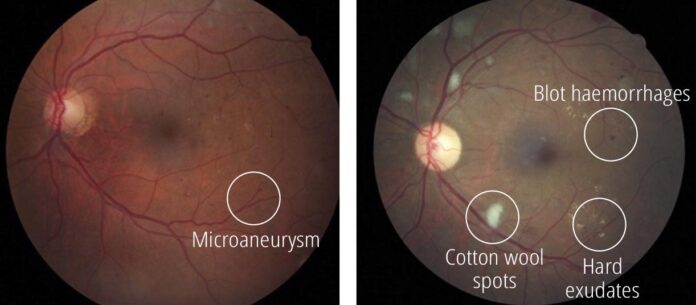
Understanding Proliferative Diabetic Retinopathy: Causes, Symptoms, and Treatment
Diabetes is a chronic disease that affects millions of people worldwide. One of the serious complications of diabetes is diabetic retinopathy, a leading cause of blindness among adults. Proliferative diabetic retinopathy is the most advanced stage of this eye disease, and it requires immediate medical attention to prevent permanent damage to the eyes.
In this article, we will explore the causes, symptoms, and treatment options for proliferative diabetic retinopathy. By understanding this condition, individuals with diabetes can take proactive steps to protect their vision and overall health.
Causes of Proliferative Diabetic Retinopathy
Proliferative diabetic retinopathy occurs when the blood vessels in the retina become damaged due to high levels of blood sugar over an extended period. The retina is the lining at the back of the eye responsible for capturing images and sending them to the brain. When the blood vessels in the retina are damaged, the body responds by growing new blood vessels to compensate for the loss of blood supply.
However, these new blood vessels are weak and fragile, leading to further complications such as bleeding into the eye and scar tissue formation. The exact cause of diabetic retinopathy is not entirely clear, but it is believed to be linked to long-term uncontrolled diabetes, high blood pressure, and high cholesterol levels.
Certain risk factors can increase the likelihood of developing proliferative diabetic retinopathy, including:
-Long-standing diabetes
-Poorly controlled blood sugar levels
-High blood pressure and cholesterol
-Smoking
-Being overweight or obese
Symptoms of Proliferative Diabetic Retinopathy
Proliferative diabetic retinopathy often does not present any symptoms in its early stages, which is why regular eye exams are crucial for individuals with diabetes. As the condition progresses, the following symptoms may occur:
-Blurred or distorted vision
-Floaters or spots in the field of vision
-Partial or complete loss of vision
-Fluctuating vision
-Dark or empty spots in the vision
-Difficulty seeing at night
These symptoms indicate that the blood vessels in the retina are leaking or bleeding, leading to vision impairment. If left untreated, proliferative diabetic retinopathy can cause severe vision loss or blindness.
Treatment of Proliferative Diabetic Retinopathy
Early detection and treatment of proliferative diabetic retinopathy are essential to prevent irreversible damage to the eyes. The main goal of treatment is to stop the growth of abnormal blood vessels in the retina and prevent further complications. Here are some common treatment options for proliferative diabetic retinopathy:
1. Laser surgery: Laser therapy is the most common treatment for proliferative diabetic retinopathy. This procedure uses a focused beam of light to seal off leaking blood vessels and prevent the growth of new blood vessels. Laser surgery is usually performed on an outpatient basis and has a high success rate in preserving vision.
2. Eye injections: In some cases, anti-vascular endothelial growth factor (anti-VEGF) injections may be prescribed to reduce swelling and leakage in the retina. These injections help to stabilize the condition and improve vision in patients with proliferative diabetic retinopathy.
3. Vitrectomy: In advanced cases of proliferative diabetic retinopathy, a vitrectomy may be required to remove blood and scar tissue from the eye. During this surgical procedure, the vitreous gel in the eye is removed and replaced with a clear solution to restore vision.
4. Diabetic management: Controlling blood sugar levels, blood pressure, and cholesterol is essential in managing proliferative diabetic retinopathy. By following a healthy lifestyle, including regular exercise, a balanced diet, and medication management, individuals with diabetes can reduce the risk of complications and preserve their vision.
Preventing Proliferative Diabetic Retinopathy
While proliferative diabetic retinopathy cannot always be prevented, there are steps individuals with diabetes can take to reduce their risk of developing this serious eye condition. Here are some tips for preventing proliferative diabetic retinopathy:
1. Maintain good blood sugar control: Keeping blood sugar levels within the target range can help reduce the risk of diabetic retinopathy. Regular monitoring of blood glucose levels and following a diabetes management plan prescribed by a healthcare provider is essential for overall health.
2. Control blood pressure and cholesterol: High blood pressure and cholesterol can accelerate the progression of diabetic retinopathy. Managing these risk factors through medication, diet, and exercise can help protect the eyes and prevent complications.
3. Attend regular eye exams: Routine eye exams are crucial for detecting diabetic retinopathy in its early stages. An ophthalmologist can perform a comprehensive eye exam to assess the health of the retina and recommend appropriate treatment options if diabetic retinopathy is present.
4. Quit smoking: Smoking can constrict blood vessels and worsen the effects of diabetes on the eyes. Quitting smoking can improve overall health and reduce the risk of complications associated with proliferative diabetic retinopathy.
In conclusion, proliferative diabetic retinopathy is a serious eye condition that can lead to vision loss if left untreated. By understanding the causes, symptoms, and treatment options for this condition, individuals with diabetes can take proactive steps to protect their vision and overall health. Regular eye exams, good blood sugar control, and a healthy lifestyle are key to managing proliferative diabetic retinopathy and preventing complications. If you have diabetes and are experiencing vision changes, it is essential to seek medical attention promptly to prevent permanent damage to the eyes.












